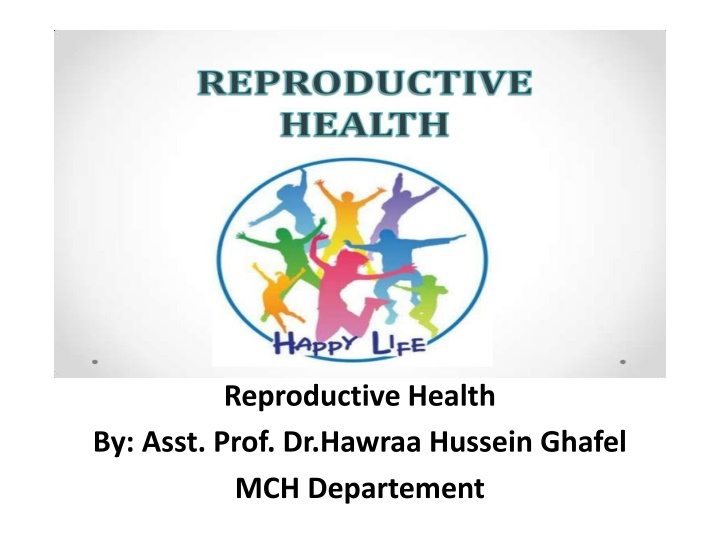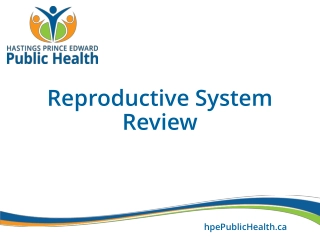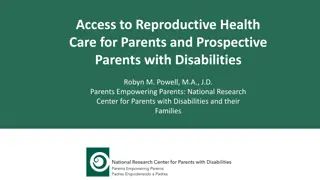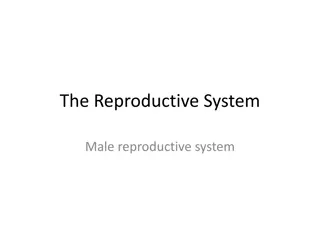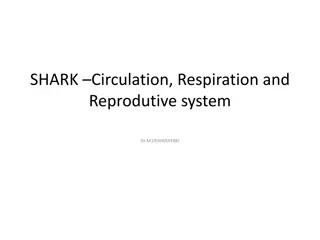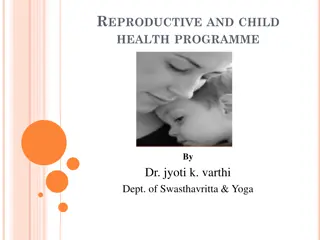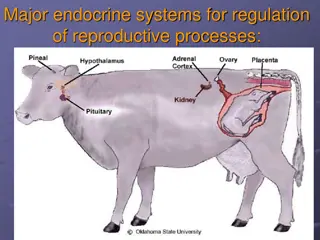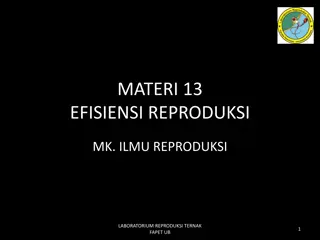Reproductive Health
Reproductive health encompasses physical, mental, and social well-being related to the reproductive system. Learn about key components like family planning, maternal health, and safe abortion services. Explore essential indicators such as total fertility rate and contraceptive prevalence to understand and promote reproductive health effectively.
Download Presentation

Please find below an Image/Link to download the presentation.
The content on the website is provided AS IS for your information and personal use only. It may not be sold, licensed, or shared on other websites without obtaining consent from the author.If you encounter any issues during the download, it is possible that the publisher has removed the file from their server.
You are allowed to download the files provided on this website for personal or commercial use, subject to the condition that they are used lawfully. All files are the property of their respective owners.
The content on the website is provided AS IS for your information and personal use only. It may not be sold, licensed, or shared on other websites without obtaining consent from the author.
E N D
Presentation Transcript
Reproductive Health By: Asst. Prof. Dr.Hawraa Hussein Ghafel MCH Departement
Content of the lecture Reproductive Health Definition and Indicators Components of Reproductive Health Maternal Health Family Planning Sexually Transmitted Infections Abortion Violence Against Women
Definition of Reproductive health Reproductive health is defined as A state of complete physical, mental, and social well being and not merely the absence of disease or infirmity, in all matters related to the reproductive system and to its functions and process .
Components of Reproductive Health 1.Quality family planning services 2. Promoting safe motherhood: prenatal, safe delivery and post natal care, including breast feeding 3. Prevention and treatment of infertility 4. Prevention and management of complications of unsafe abortion 5.Safe abortion services 6.Treatment of reproductive tract infections including sexually transmitted infections;
Components of reproductive health 7. Information and counseling on human sexuality, responsible parenthood and sexual and reproductive health 8. Active discouragement of harmful practices, such as female genital mutilation and violence related to sexuality and reproduction
Reproductive Health indicators 1. Total Fertility Rate: Total number of children a woman would have by the end of her reproductive period, if she experienced the currently prevailing age-specific fertility rates throughout her childbearing life. TFR is one of the most widely used fertility measures to assess the impact of family planning programmes.
Reproductive Health indicators 2.Contraceptive Prevalence (any method): Percentage of women of reproductive age who are using (or whose partner is using) a contraceptive method at a particular point in time.
Reproductive Health indicators 3. Maternal Mortality Ratio: The number of maternal deaths per 100 000 live births from causes associated with pregnancy and child birth. 4. Antenatal Care Coverage: Percentage of women attended, at least once during pregnancy, by skilled health personnel for reasons relating to pregnancy.
Reproductive Health indicators 5. Births Attended by Skilled Health Personnel: Percentage of births attended by skilled health personnel. This doesn t include births attended by traditional birth attendants. 6. Availability of Basic Essential Obstetric Care: Number of facilities with functioning basic essential obstetric care per 500 000 population. Essential obstetric care includes, Parenteral antibiotics, Parenteral oxytocic drugs, Parenteral sedatives for eclampsia, Manual removal of placenta, Manual removal of retained products, Assisted vaginal delivery. These services can be given at a health center level.
Reproductive Health indicators 7. Availability of Comprehensive Essential obstetric care: Number of facilities with functioning comprehensive essential obstetric care per 500 000 population. It incorporates obstetric surgery, anesthesia and blood transfusion facilities. 8. Perinatal Mortality Rate: Number of Perinatal Deaths (deaths occurring during late pregnancy, during childbirth and up to seven completed days of life) per 1000 total births. Deaths which occur starting from the stage of viability till completion of the first week after birth (22 weeks of gestation up to end of first week after birth, WHO). Total birth means live birth plus IUFD born after fetus reached stage of viability.
Reproductive Health indicators 9. Low birth Weight Prevalence: Percentage of live births that weigh less than 2500 g. 10. Positive Syphilis Serology Prevalence in Pregnant Women: Percentage of pregnant women (15 24) attending antenatal clinics, whose blood has been screened for syphilis, with positive serology for syphilis.
Reproductive Health indicators 11. Prevalence of Anemia in Women: Percentage of women of reproductive age (15 49) screened for haemoglobin levels with levels below 110 g/l for pregnant women and below 120 g/l for nonpregnant women. 12. Percentage of Obstetric and Gynaecological Admissions Owing to Abortion: Percentage of all cases admitted to service delivery points providing in-patient obstetric and gynaecological services, which are due to abortion (spontaneous and induced, but excluding planned termination of pregnancy)
Reproductive Health indicators 13.Reported Prevalence of Women with FGM: Percentage of women interviewed in acommunity survey, reporting to have undergone FGM. 14. Prevalence of Infertility in Women: Percentage of women of reproductive age (15 49) at risk of pregnancy (not pregnant, sexually active, noncontraception and non-lactating) who report trying for a pregnancy for two years or more
Reproductive Health indicators 15. Reported Incidence of Urethritis in Men: Percentage of men (15 49) interviewed in a community survey, reporting at least one episode of urethritis in the last 12 months. 16. HIV Prevalence in Pregnant Women: Percentage of pregnant women (15 24) attending antenatal clinics, whose blood has been screened for HIV, who are sero-positive for HIV.
Reproductive Health indicators 17.Knowledge of HIV-Related Prevention Practices: The percentage of all respondents who correctly identify all three major ways of Reproductive Health preventing the sexual transmission of HIV and who reject three major misconceptions about HIV transmission or prevention
Maternal Health Motherhood should be a time of expectation and joy for a woman, her family, and her community. For women in developing countries, however, the reality of motherhood is often grim. For those women, motherhood is often marred by unforeseen complications of pregnancy and childbirth. Some die in the prime period of their lives and in great distress: from hemorrhage, convulsions, obstructed labor, or severe infection after delivery or unsafe abortion.
Safe Motherhood The strategies adopted to make motherhood safe vary among countries and include: 1. Providing family planning services. 2. Providing post abortion care. 3. Promoting antenatal care. 4. Ensuring skilled assistance during childbirth 5. Improving essential obstetric care. 6. Addressing the reproductive health needs of adolescents.
Essential Services for Safe Motherhood Safe motherhood can be achieved by providing high quality maternal health services to all women. These services for safe motherhood should be readily available through a network of linked community health care providers, clinics and hospitals. These services could be provided at different levels including home and health institutions.
Essential Services include: 1. Community education on safe motherhood 2. Prenatal care and counseling, including the promotion of maternal nutrition 3. Skilled assistance during childbirth 4. Care for obstetric complications, including emergencies 5. Postpartum care
Essential Services include: 6. Post-abortion care and, where abortion is not against the law, safe services for the termination of pregnancy 7. Family planning counseling, information and services 8. Reproductive health education and services for adolescents
Maternal Mortality Definition : maternal death as the death of a woman while pregnant or within 42 days of termination of pregnancy, irrespective of the duration and site of the pregnancy, from any cause related to or aggravated by the pregnancy or its management, but not from accidental or incidental causes.
Maternal Morbidity Definition : Any deviation, subjective or objective, from a state of physiological or psychological well being of women.
Causes of Maternal Mortality and Morbidity 1.Direct Obstetric Deaths : are those that result from obstetric complications of the pregnancy state from interventions, omissions, incorrect treatment or from chain of events. Examples: Abortion, Ectopic pregnancy, pre- eclampsia, Eclampsia, Obstructed labor, infection, etc.
Causes of Maternal Mortality and Morbidity Commonest Direct Obstetric Cause: A. Hemorrhage: Includes antepartum, postpartum, abortion, and ectopic pregnancy. B. Unsafe Abortion: It is claimed as the commonest cause of maternal death in our country accounting for 20 40% of deaths. C. Hypertensive disorders of pregnancy: This includes pre-eclampsia, eclampsia, etc. Preclampsia and eclampsia account for 10- 12% of maternal deaths.
Causes of Maternal Mortality and Morbidity Commonest Direct Obstetric Cause: D. Obstructed Labor and uterine rupture: The prevalence of obstructed labor is said to be 47 % in Ethiopia. It accounts for 9% of the total maternal death. E. Infection: The introduction and multiplication of microbial agents in the pelvic organs and other systems having an effect on the health of the mother and newborn. It includes infection of the uterus, tubes, urinary system and fetal infection. It accounts for 10% of maternal deaths.
Causes of Maternal Mortality and Morbidity Indirect Obstetric Death: Deaths resulting from previous existing diseases or diseases that developed during pregnancy A. Anemia: This is the commonest indirect cause of maternal death in our country, since malaria is endemic and iron supplementation is low B. Other indirect causes include, heart disease, diabetes mellitus, HIV/AIDS, TB, Malnutrition, etc. The indirect obstetric death:
Maternal Mortality in Context: The Three D s (Delays) 1. Delay in deciding to seek care Failure to recognize signs of complications Failure to perceive severity of illness Cost consideration Previous negative experience with the health system Transportation
Maternal Mortality in Context: The Three D s (Delays) 2. Delay in reaching care Lengthy distance to a facility Conditions of roads Lack of available transportation
Maternal Mortality in Context: The Three Ds (Delays) 3. Delay in receiving appropriate care Uncaring attitudes of providers Shortages of supplies and basic equipment Non-availability of health personnel Poor skills of health providers
Causes of Maternal Morbidity Maternal morbidity is difficult to measure due to variation in the definition and criteria to diagnose. The risk factors for maternal morbidity include prolonged labor, hemorrhage, infection, preclampsia, etc.
Factors affecting women health 1.Socio-cultural factors: Like early marriage, early childbirth, harmful traditional practices including female genital mutilation, etc.
Factors affecting women health 2. Economy: Socio economic status affects the women s status by affecting their decision making roles in the community, educational status, health coverage, level of sexual abuse, etc.
Factors affecting women health 3. Inadequate Health Service Coverage: Most mothers do not get care during pregnancy and most deliveries are unattended. This is due to lack of transportation, distance from health facilities, small number of health facilities, etc
Factors affecting women health 4. Psychological factors: For instance, after sexual abuse women are at great risk of depression. 5.Health and nutrition services: The health status of women who are not getting adequate amount of nutrients and proper reproductive health services could be affected.
Factors affecting women health 6. Interaction with providers: Some health care providers are, unsympathetic and uncaring as they do not respect women's cultural preferences. E.g. privacy, birth position, or treatment by women providers. 7.Gender Discrimination: E.g. lack of women empowerment, giving more attention to a male child.
Family planning Definition: Family Planning involves planning the number, frequency and timing of pregnancy. In other words it is a program to regulate the number and spacing of children in a family through the practice of contraception or other methods of birth control
Benefits of family planning to womens health 1. Avoiding pregnancy at the extremes of maternal age 2. Decreasing risks by decreasing parity: If all women had five births or fewer, the number of maternal deaths could drop by 26 % worldwide. 3. Preventing high-risk pregnancies: decrease maternal deaths by quarter 4. Prevention of unwanted pregnancy: reduces unnecessary risks of pregnancy, childbirth and risks of induced abortion 5. Improving health through non-contraceptive benefits including prevention of STIs and reproductive cancers
Types of Family Planning 1.Hormonal contraceptive methods : include oral contraceptives pills, injectables, and implants. They all prevent pregnancy mainly by stopping a woman s ovaries from releasing eggs. Hormonal methods contain either one or two female sex hormones that are similar to the hormones naturally produced by a woman s body.
Types of Family Planning 2.Oral contraceptive pills: should be taken one pill every day. They are most effective when no pills are missed, the pill is taken at the same time every day,and each new pack of pills is started without a delay.
Types of Family Planning 3.Injectable contraceptives: are given by injection into a woman s arm or buttocks once every 1, 2, or 3 months, depending on the type of injectable. Injectables are most effective when women remember to come back for re-injection on time.
There are 3 different varieties of Injectable Contraceptives available 1. Monthly Injectable Cyclofem/ Cycloprovera and Mesigyna/ Norigynon. 2.Bi-monthly Injectable Noristerat and Norethindrone Enanthate NET-EN 3. Quarterly Injectable DMPA (Depo medroxy progesterone acetate)
Types of Family Planning 4.Contraceptive implants: are inserted under the skin of a woman s upper arm and provide continuous, highly effective pregnancy protection for 3 to 5 years, depending on the type of implant. When this time is over, new implants can be inserted during the same visit that the old set is removed.
Types of Family Planning 5.Emergency contraceptive pills (ECPs): can help prevent pregnancy if taken within 5 days after unprotected sex. The sooner they are taken, the more effective they are. They are NOT meant to be used for ongoing contraception, in place of a regular method.
Emergency contraceptive pills Pills can be taken after unplanned, unprotected coitus as emergency contraceptive after consulting the doctor . A dose of 4 tablets of a low dose pill within 72 hours of un protected intercourse followed by 4 more tablets 12 hours later.
Types of Family Planning 6.Intrauterine contraceptive devices (IUDs or IUCDs): are small, flexible plastic devices that are inserted into the woman s uterus. The most common IUDs contain copper, and they work by preventing sperm from reaching an egg. Depending on the type, IUDs can provide protection for 5 to 12 years
Types of Family Planning 7.Barrier methods are either devices (male and female condoms): that physically block sperm from reaching an egg, or chemicals (spermicides) that kill or damage the sperm in the vagina. The effectiveness of barrier methods greatly depends on people s ability to use them correctly every time they have sex.
